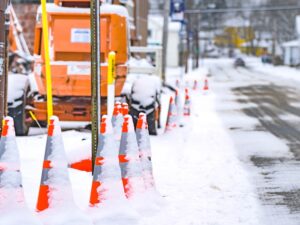September 13, 2023
Given recent media interest regarding reinforced autoclaved aerated concrete (RAAC), Sedgwick’s liability claims services group consider what the potential issues are, and what the current liability implications might be.
What is RAAC?
Autoclaved aerated concrete (AAC) is different from normal dense concrete in that it has no coarse aggregate and is made in factories using fine aggregate and chemicals to create gas bubbles and heat to cure the compound.
It is relatively weak with a low capacity for developing bond with embedded reinforcement. It was used in two main forms of structural elements: lightweight masonry blocks and structural units (such as roof planks, wall, and floor units).
When reinforced to form structural units, a bituminous or a cement latex coating is applied to the reinforcement prior to casting the planks in order to protect the reinforcement against corrosion. The reinforcement mesh is then introduced into the formwork and the liquid AAC mix.
RAAC was used in schools, colleges, and other building construction from the 1950s until the mid-1990s. At the time it was considered efficient, light and cheap; however, RAAC has the following embedded systemic problems:
- RAAC panels have low compressive strength, around 10-20% of traditional concrete, meaning the shear and bending strength is reduced. Water saturation can further impact this strength.
- It is very porous and highly permeable, meaning the steel reinforcement within the panels is less protected against corrosion ‘rusting’ than steel reinforcement in traditional concrete.
- The reinforcement within RAAC panels is not as well-bonded to the surrounding concrete. The dominant connection is via secondary reinforcement (transverse reinforcement).
- It is aerated (looks ‘bubbly’) and contains no ‘coarse’ aggregate, therefore it is less dense than traditional concrete — around a third of the weight.
- RAAC has reduced ’stiffness’ characteristics resulting in high displacements, deflections and sagging.
- The bearing of planks is often insufficient by comparison to modern standards, which presents a significant risk.
- Limited quality control during manufacture and installation means a high degree of variability between panels.
RAAC panels have material and construction deficiencies making them less robust than traditional concrete. This increases the risk of structural failure which, as the recent media interest has highlighted, can be gradual or sudden with no prior warning.
History
In 1996, the Building Research Establishment (BRE) published an information paper which stated that excessive deflections and cracking had been identified in several RAAC roof planks and evidence of the initiation of reinforcement corrosion was found:
“However, there is no evidence so far to suggest that RAAC planks pose a safety hazard to building users. This paper describes the difficulties experienced in service with RAAC roof planks designed before 1980. It gives guidance on their identification and initial assessment in buildings. It suggests that roofs incorporating RAAC planks, which were designed before 1980 are inspected and their condition assessed. Although no specific examples of excessive deflections of floors have been reported, it may be wise to inspect RAAC components within floors”.
This was followed in 2002 with further information on performance issues, laboratory testing and advice on inspection.
Standing Committee on Structural Safety (SCOSS) also warned of the problem in the Twelfth Report of SCOSS in 1999 (see Section 3.5 Reinforced Autoclaved Aerated Concrete). Since then, there will have been deterioration, possibly effects from maintenance or refurbishment, or a change in environment, all of which can adversely affect long-term performance.
The then Department for Education (DfE) asked BRE to inspect several school roofs in Essex. The results were reported in BRE Information Paper IP10/96. This report, which was limited to RAAC planks designed before 1980, concluded that ‘there is no evidence so far to suggest that RAAC planks pose a safety hazard to building users.’ The DfE sent a warning to all schools referencing the information paper and advising inspection and assessment of roofs incorporating RAAC planks. As a result, Essex County Council inspected some 60 school buildings; therefore, the BRE investigation did not suggest a need for SCOSS to examine the topic at that time.
In December 2018 the DfE and the Local Government Association made building owners aware of a recent building component failure in a property constructed using RAAC. In May 2019, the SCOSS raised an alert to emphasize the potential risks from such construction, highlighting the failure in an operational school. The collapse came without warning.
The DfE subsequently issued a further guidance note in August 2023 following further collapses.
Management
When a premises is identified as potentially containing RAAC — or if there is uncertainty — an appropriately qualified building surveyor or structural engineer with RAAC experience should confirm if RAAC is present.
An initial inspection procedure, outlined in the 1996 BRE Information Paper IP 10/96 – Reinforced Autoclaved Aerated Concrete planks designed before 1980, says to inspect the soffit of possible RAAC planks for indications of excessive deflection and to inspect roofs from above for signs of rainwater ponding. If these signs are present, the structural roof planks may be of RAAC construction; it could also mean another form of construction is not behaving as expected. Inspections from above should be done from a place of safety (e.g. a nearby vantage point, drone, mobile elevated work platform, scaffolding).
Where RAAC planks have been identified, an owner/building manager should take the following steps:
- Conduct a risk assessment. The use of space beneath a roof will affect the risk assessment; a classroom will be a higher risk than a shop. If there is doubt about the structural adequacy of the planks and/or there is evidence of water ingress, it is advisable to consider replacing them. The use of the space beneath the roof may need to be discontinued until the roof has been strengthened or replaced.
- Consider the long-term plan for the RAAC roof. In some cases, replacing the roof will be necessary. In other cases, regular inspection may be merited, and records kept in order to readily assess any significant changes in behaviour.
- Ask maintenance staff, facilities managers, contractors and others who have access to the building about roof ponding, roof leaks, cracks on the underside of flat roofs or other signs of deterioration.
- Check with the same people about any resurfacing that may affect the roof’s load. This includes checking if a levelling compound was used to recreate the roof fall prior to replacing waterproofing.
- Check the colour of the roof surfacing; if it’s black it may indicate enhanced sensitivity to thermal effects.
- Ensure that all staff know to report any leaks, cracks or other potential defect issues.
- If there are sudden changes (e.g. audible cracking sounds, greatly increased water ingress, observable deflection), then the area should be immediately closed off. This would apply to any form of structure.
- Any such observations could be warning signs; seek out expert attention from an appropriately experienced chartered structural engineer or chartered building.
Liability
The potential liabilities that might arise from discovering RAAC in a building do not arise simply because of its presence. RAAC is only a risk in specific situations. Once RAAC is identified, it needs to be inspected by a suitably qualified chartered building surveyor or structural engineer to consider the risk of collapse and how it should be managed or prevented.
Failing to identify RAAC and adequately assess and manage the risk is where a potential liability arises. From the perspective of an original installing contractor, or others in the build contract chain, liability is associated with their knowledge of the risk posed by the RAAC. Liabilities from the original installation are, for the most part, statute barred notwithstanding that state of knowledge defence.
The DfE is the best current authority to advise and recommend what approach to take where RAAC is identified.
The recent publicity around RAAC dictates that a state of knowledge must now be deemed to exist. As a result, if a property owner or manager is aware, or should reasonably be aware, of the presence of RAAC at a site, they have an obligation to warn of its presence and the risk posed, and to recommend that a survey of condition is undertaken. There is also a duty to warn of and to confirm any required investigative and remedial measures.
In summary:
- The mere presence of RAAC will not create a liability.
- The future failure to identify and warn could potentially create a liability.
- Originating builders and subcontractors are almost certainly statute barred.
Learn more > contact [email protected].



